Apple's iPhone 4: Thoroughly Reviewed
by Brian Klug & Anand Lal Shimpi on June 30, 2010 4:06 AM EST- Posted in
- Smartphones
- Apple
- iPhone 4
- Gadgets
- Mobile
FaceTime
Meet Manveer. I’ve known him since I was in the 6th grade. Somewhere around the 8th grade we started a ritual of calling each other every day after school and talking about video games, computers and dumb things that happened at school. We talked on the phone for hours. Back in those days we would even play the same game on separate computers while talking on the phone. It was a precursor to voice chat in gaming networks like Steam or Xbox Live. It was ridiculous amounts of fun.
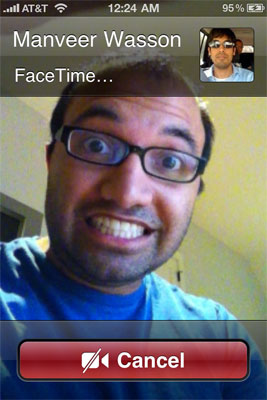
Manveer is up in the corner, the crazy guy is yours truly
Tonight Manveer and I FaceTimed. It’s the feature I wish we had when we were back in middle school. These days it’s a lot harder to explain why you’ve got some random dude’s face on your phone talking to you about completely pointless things at 12:54AM on a Tuesday night. I spent part of the chat covering one of the lights in my room with my head and calling it an Anand Head Eclipse. At the risk of further embarrassing myself publicly, it was fun.
For those of you who don’t know, FaceTime is Apple’s VoIP protocol built into the iPhone 4.
Granted we’ve been able to do this sort of thing for quite a while now over instant messenger networks. Integration into your smartphone is just the next logical step, and in the right conditions it works very well.
 |
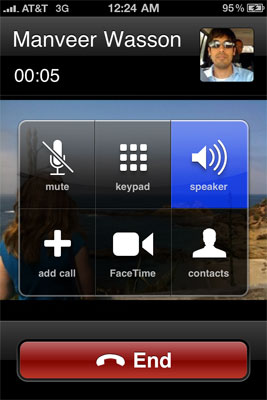 |
The first requirement is that both users need to have an iPhone 4 obviously. Both also need to be on WiFi. While the FaceTime icon will appear if you call another iPhone 4, if you try to activate the connection you’ll get this error unless you’re on WiFi:
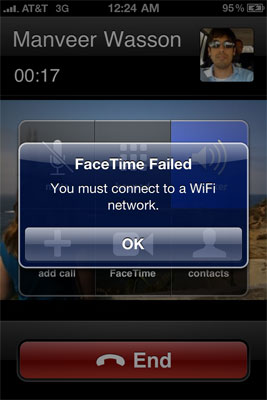
With a bit of poor UI design Apple will actually display a FaceTime icon with a question mark in it if you call another iOS phone. Trying to activate FaceTime however gives you an error.
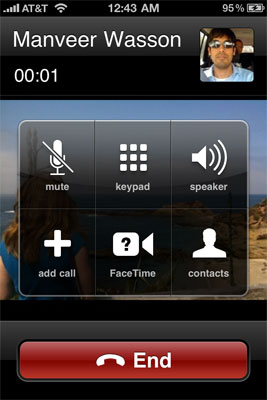 |
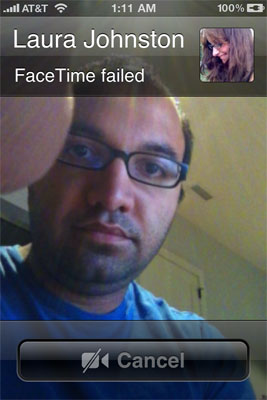 |
FaceTime requires roughly 100 - 150Kbps of bandwidth in both directions to work smoothly. The download should be fine but the upload is pretty high given that many broadband providers in the US are ridiculously stingy with their upload bandwidth. For FaceTime to work well you can’t be uploading or downloading anything large in the background, or if you are just throttle everything else to give you enough bandwidth to work with.
The next problem with FaceTime is the iPhone 4 lacks an absolutely necessary integrated stand. HTC got it perfect with the EVO 4G, unfortunately the 4 has no such thing. The closest you can get is Apple’s iPhone 4 dock, it’ll set you back $29 but it’s necessary to prevent you from getting tired holding your phone out in front of you. Laying the 4 down on your desk while you FaceTime just gives the person on the other end of the line a great view of your nostrils. Not very welcoming.
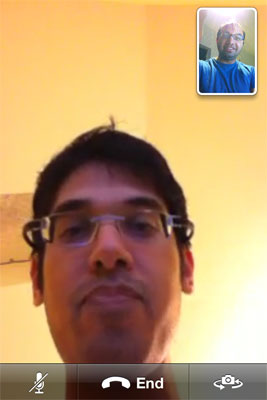
This is the on-table view of FaceTime, you need a stand
Even once you’ve met all of the requirements it’s still not a guaranteed thing. Even with ample bandwidth I had one FaceTime chat stall in the middle of the chat. My incoming feed froze and I had to wait a couple of seconds for it to resume. I also had a problem where FaceTime would fail to start on the first try. A subsequent try fixed it.
As you'll see in our camera investigation, the low light performance of the 4's front facing camera is horrid. Couple that with FaceTime and you will get bad image quality if you're not in a well lit room:

Ugh, what is this, 1998?
While in FaceTime you can easily switch between front and rear cameras by tapping the camera icon in the lower right corner. Unfortunately the compression on the video is enough to render text illegible while in FaceTime:
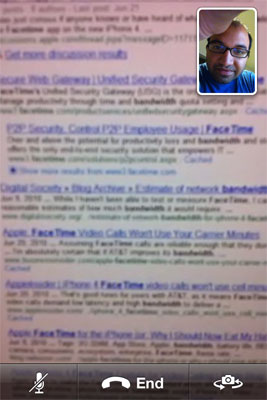
This was taken using the rear facing camera over FT
Obviously everyone knows where FaceTime is going. Apple is supposedly opening the protocol up to all developers, so you’d be able to theoretically build desktop and other smartphone FaceTime clients. And ultimately as mobile broadband speeds (hello WiMAX and LTE) improve the WiFi requirement will be dropped. But is it a good feature today?
It really depends on who you know with an iPhone 4. If you’ve got a Manveer, absolutely - the feature is worth it. If you have a bunch of casual acquaintances with iPhone 4s, probably not. It’s only useful if you know the person on the other side very well.
There is one other major benefit to FaceTime. Once enabled your call is routed over WiFi to the Internet, not AT&T’s 3G network. It doesn’t use any of your plan’s minutes and more importantly, voice quality is much improved over a regular 3G/EDGE phone call. It’s VoIP, not a crappy cell connection. Even if you just cover the camera it’s actually better to make calls over FaceTime than 3G based on the sound quality alone.










270 Comments
View All Comments
Lemurion - Friday, July 2, 2010 - link
I was disappointed that you they only compared the iPhone 4 screen to the 800 by 480 AMOLED screens on some of the Android devices. As far as I know, all those devices use the Pentile system, which reduces the crispness of text.I would have really liked to compare the new Apple screen to the Motorola Droid's 266 PPI screen and see how noticeable the difference there was.
Matt Campbell - Friday, July 2, 2010 - link
Nice investigation work on the signal strength. Just wanted to point out that AnandTech is cited in the Apple iPhone 4 software fix story on CNN today. http://www.cnn.com/2010/TECH/mobile/07/02/apple.ip...Bad Bimr - Friday, July 2, 2010 - link
http://www.cnn DOT com/2010/TECH/mobile/07/02/apple.iphone.apology/index.htmlJust like apple, finally admitting a problem, pleasing the fan boys by saying it will be addressed and doing nothing to fix it. I am so glad I never jumped on the apple bandwagon.
fischerm83 - Friday, July 2, 2010 - link
So i was reading various news articles today and saw that apple finally figured out/admitted to what you guys found out earlier this week...*quote*
Now the company says its engineers have made a "stunning" discovery. Reception is poor and calls may be dropped because not only are people holding the phone wrong, but they also think they have a better signal than they do. In the statement, Apple says that it has made a mistake in the formula that calculates the number of bars that display the signal strength on all of its iPhones.
"We were stunned to find that the formula we use to calculate how many bars of signal strength to display is totally wrong," it said in a statement.
*quote*
Full Article:
http://news.cnet.com/8301-30686_3-20009564-266.htm...
Nice work guys, keep up the amazing work!
anandreader - Friday, July 2, 2010 - link
Brian-I'm confused as to what had to happen to get Fieldtest onto the iphone 4. Understood the bit about jailbreaking the iphone3 but didn't understand how that information got transfered to the 4.
Could you elaborate a bit there?
Per Grenerfors - Friday, July 2, 2010 - link
Thanks for the great review, AnandTech.In countries where 3G coverages isn't spotty like a teenagers face, the whole antenna/at&t/verizon debate is just utterly unnecessary.
Apple is the only brand name in tech today that's recognized by the broader public. Their products therefore make a big splash in the media when they hit the market. But the bigger splash you make, the more mud comes floating up from the bottom. Like people complaining with a spec sheet in hand without ever having seen the device in real life. Or just plain old haters. This is the downside to fame. But I'm sure Apple's laughing all the way to the bank.
Stokestack - Friday, July 2, 2010 - link
A case isn't an acceptable workaround for this. I don't buy a thin phone to bulk it up and junk it up with a cheesy case or add-on of any kind.While I'm not planning on getting an iPhone 4, if I had one and wanted to keep it I'd try to spray a coating onto the antenna band. I'd mask the front & back, the buttons, and any seams, then spray with polyurethane or something. While it would be microscopically thin, there's be no direct contact with skin. And really, that's what you said you expected Apple to have done anyway. Let's see if it would work.
Excellent review. The hack to get the numeric signal strength rocks.
Fulle - Friday, July 2, 2010 - link
Thank you for the review. It was useful to be able to look at something that was detailed, and included facts, good and bad, without a ridiculous amount of bias. It's obvious that Anand likes, or at least really wants to like most Apple products, but it was nice that that didn't get in the way of the review.The new iPhone seems to be an OK device that's on par with new Android smartphones in way of hardware... The screen's got 20% higher pixel density than the Droid, but 50% worse contrast ratio, and worse black quality... Java performance is clearly inferior to a Nexus One, but browsing performance is competitive (I'd say good, but I think all handsets have shit browser performance). Its sleak and thin, but it has no hardware qwerty. The 5MP camera produces low noise, but, the white balance is messed up, making it overall inferior to the camera in a Nexus One or HTC Incredible (or Moto Droid, even, IMHO... screwed up over-saturated colors with bad white balance are a big deal to me). Overall, it's an average device when put up against worthy competition (EVO4G, DroidX, HTC Incredible, Nexus One, or even a Moto Droid).
But, that's before you have to deal with the obvious design flaws. Glass panels on both sides? WTF? Uninsulated external antenna? These aren't minor flaws here.
So, overall I'd say that the new iPhone is inferior to at least 6 Android smartphones.... and at first I grin at that... but then I'm disappointed and mad. Apple has helped make the smartphone market the competitive environment it is today, and when they drop the ball like this, it means that other venders don't have to raise the quality of their devices to compete. It's just fortunate that Android has so many hardware OEMs, like HTC, Samsung, and Motorolla, all competing with each other... or else I'd be afraid the only thing the iPhone4 would push in competition is a higher ppi on the screens.
Lets hope this helps push the Cortex-A9 equipped Android's this winter to include higher resolution in their displays... but, man, I'm disappointed with this device.
tgibbs - Friday, July 2, 2010 - link
Does zero dB represent a standard absolute signal strength or is it an arbitrary reference value that will differ for different phones?navderek - Saturday, July 3, 2010 - link
The signal is actually measured in dBm which means it is a reference to 1mW of power.For example -30dBm = 1000 times less that 1mW = 1uW
1 microwatt does not seem like much, but actually this is a very strong signal for the mobile and you would rarely have that much power arriving at your handset from the tower. In good conditions, close to the tower or serving antenna with minimal obstructions you could expect about -50 to -60 dBm (-60dBm = 1nW (nanowatt). The system is designed to deal with such small signals...this is why I laugh when people are worried about cell tower "radiation" when actually 5 min. in the sun is a bazzillion times more radiation than what's coming out of a tower....cellular towers that is, broadcast radio towers or paging systems are another story!
But I digress...to answer your question simply, zero dBm simple equals 1mW.
Zero dBm signifies that there is no difference in ratio from the reference of 1mW.